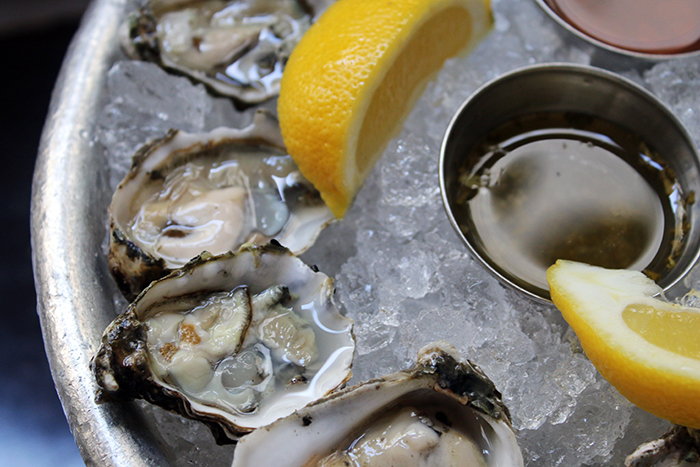A few weeks ago I discussed our good fortune to have oysters as our local food crop. These treasures of the ocean from nearby waters are considered some of the best available anywhere. They are delicious freshly opened on the half shell and can also be baked, grilled, fried, stewed, scalloped, and more. But they can be a little intimidating with their sturdy shells and unstructured texture.
All East Coast Oysters are the same species, known collectively as Blue Point. But for an oyster, you are what you eat. The water conditions including temperature, salinity, and mineral content influence the taste. So oysters, like French wine, have terroir and are named after their place of origin; locally Copps Island or Cedar Point, brands of the extended Bloom families. You will see names from further afield, too, like Wellfleet and Chatham from Cape Cod or Chincoteague from Virginia. Although oysters are found all along the East Coast, the cold waters of New England produce the best and most distinctive flavors.
“Oysters R in season” is an oft quoted bit of folk wisdom which means that oysters are only good in months with an R in the name (so not in May, June, July or August.) There are several likely sources for this adage: Prior to modern refrigeration, oysters could spoil in transit; Summer is the season when oysters put all of their energy into spawning, somewhat depleting their flavor; and warmer waters can potentially introduce unwelcome organisms. Refrigeration and modern oyster farming techniques have all but eliminated these issues. Flavor is at its peak in the cold months, but you can feel free to enjoy oysters year round.
Oysters can be purchased in the shell, professionally shucked without the shells, or in restaurants where all the work is done for you. At seafood counters and fish markets you‘ll find oysters in the shell, graded by size and sold by the piece. Fresher is always better, but they will last a couple of weeks in a cool moist environment. Fresh oysters will be tightly closed. Strike two oysters together to test their freshness. A solid sound, like striking rocks against each, other is what you want.
Opening oysters is not as difficult as you may think. There are several excellent videos on YouTube showing the step by step how to. Like many things, it takes a little practice. Look for ones by About.com, Fine Cooking, and America’s Test Kitchen. There is a knack to it – brute strength is not required.
Oysters on the half shell are the classic presentation. The bottom shell, called the cup, is rounded and will hold the juice. The top or lid, is flat and is discarded after opening. Unadorned, the oysters are rich and sumptuous. A little acidity like a squirt of lemon or a dash of mignonette sauce (sherry vinegar-shallot vinaigrette) cuts the natural richness. Some like a dash of hot sauce, but there is really no place for red “cocktail” sauce, which masks the oyster’s natural briny delicacy.
Oysters on the half shell can be baked on the half shell with a topping for a delicious variation. Rockefeller-style with a spinach topping is a classic. Pernod, an anise flavored liquor, is the usual seasoning for the spinach. Traditionally, the oysters were baked on a bed of rock salt to keep them from tipping in the oven and to hold the heat when served.
In the grilling season, set a few oysters on a hot grill and the shells will open of their own accord. They still need to be cut from the shell, but this can be a shortcut to opening.
Oysters can also be bought already shucked – usually by the pint. This is ideal if you’re using them for cooking. Plan to use them right away. After shucking, shelf life declines. Oyster stew is a traditional and delicious way to cook oysters. The basic idea is to simmer the oysters in milk, but there are many variations. Some like to start with sautéing onions and celery, some add a dash of hot sauce, and there are advocates of adding herbs, most often thyme. I like to briefly cook the oysters in butter then add the milk, but others simmer the milk first then add the oysters at the last minute. Either way, be sure to include the liquid that comes with the oysters for its intense flavor. Oyster stew is traditionally served with a pat of butter melting on top, a hand full of oyster crackers and is never thickened. It’s great fun to eat at New York’s Grand Central Oyster Bar and watch the chefs make oyster stew to order in steam heated trunnion kettles.
Fried Oysters are another classic preparation. Most of us don’t have a deep fryer at home, but oysters are a good size to fry in an electric skillet where you can carefully control the temperature. A light dusting of flour or cornmeal lends a nice crunch and a tangy tartar sauce is good if it doesn’t overwhelm. They’re irresistible hot and crunchy right out of the pan. The Po’ Boy Sandwich is a New Orleans classic with fried oysters on a crisp, light baguette with fresh lettuce and a spicy remoulade sauce.
Scalloped oysters are baked in casserole with bread or cracker crumbs, butter, and cream. It’s a tasty dish and a great way to use already shucked oysters. It may take a little tinkering to get the ratio of liquid to crumbs right. The goal is to be moist without being soupy. Scalloped oysters have been around for a long time. Not often seen on restaurant menus, they are an easy way to cook oysters at home.
Whatever your preference, half shell or cooked – enjoy some oysters. It’s our home-grown product and we’re lucky to have it.












No Comment